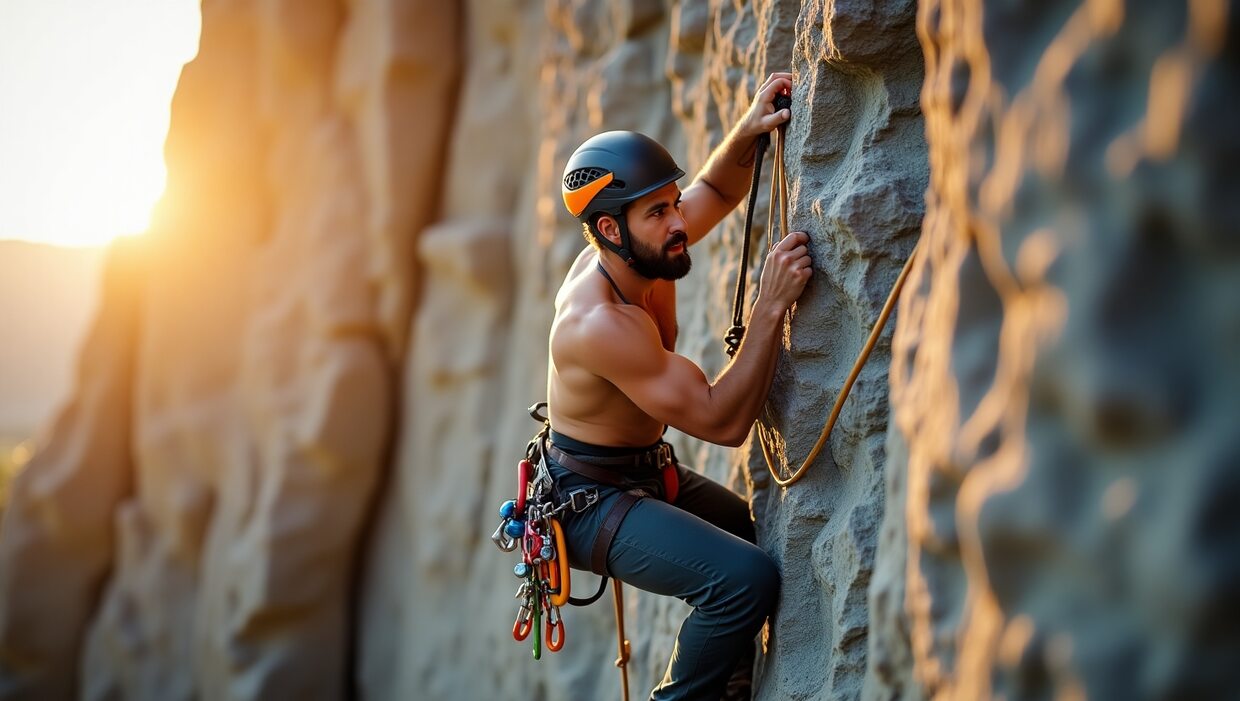Rock climbing has soared in popularity, with over 9 million Americans participating annually, drawn to its blend of physical challenge, mental focus, and connection with nature.
Whether scaling indoor walls or tackling outdoor crags, climbers push their limits, but this exhilarating sport comes with risks. Studies estimate that 10% to 81% of climbers experience injuries, with overuse injuries dominating at up to 93% of cases. For climbers, the fear of injury, uncertainty about prevention, and confusion over recovery timelines can dampen the thrill. This comprehensive guide addresses these pain points, offering evidence-based insights into common rock climbing injuries, their causes, prevention strategies, and recovery protocols. By blending expert opinions, statistical data, and a unique perspective on mental preparation, we aim to empower climbers to stay safe and climb stronger.
Understanding Rock Climbing Injuries
Climbing injuries fall into two main categories: acute injuries from falls or sudden trauma and overuse injuries from repetitive stress. Recognizing the types and symptoms is the first step to addressing them effectively.
Types of Climbing Injuries
Acute injuries, such as fractures from falls, are less common but can be severe, particularly in outdoor settings. Overuse injuries, however, are far more prevalent, affecting up to 93% of climbers, according to a 2015 study in Wilderness & Environmental Medicine. These injuries stem from repetitive strain on specific muscle groups and joints, often exacerbated by improper technique or overtraining. Understanding these distinctions helps climbers identify risks early and take preventive measures.
Common Injuries and Symptoms
Here are the most frequent climbing injuries, their symptoms, and their prevalence:
- Finger Injuries: Finger injuries, particularly to the flexor tendon pulley system (A2, A3, A4 pulleys), account for 52% of climbing injuries. The crimp grip, a common technique where fingers flex tightly while the thumb locks over, places immense stress on these pulleys. Symptoms include pain, swelling, or “bowstringing” (tendon displacement). Severe cases may involve pulley ruptures, requiring weeks of recovery.
- Shoulder Injuries: Affecting 33% to 51% of climbers, shoulder issues like superior labral anterior-posterior (SLAP) tears or subacromial impingement arise from repetitive overhead movements. Symptoms include dull or sharp pain, reduced range of motion, or weakness during dynamic moves on overhanging routes.
- Elbow and Wrist Injuries: Conditions like lateral epicondylitis (tennis elbow) and triangular fibrocartilage complex (TFCC) tears are common, especially in sport climbers. These result from repetitive gripping and wrist flexion, causing aching pain or stiffness, particularly when flexing the wrist toward the pinky.
- Lower Extremity Injuries: Ankle injuries, including fractures, make up 46% of acute injuries, often from awkward landings in bouldering or falls in outdoor climbing. Symptoms include swelling, instability, or difficulty bearing weight.
- Multisystem Trauma: In outdoor climbing, 38% of accidents treated in emergency departments involve multiple body regions, with a mean Injury Severity Score (ISS) of 7.5, according to a 2012–2018 Swiss study.
By recognizing these symptoms early, climbers can seek timely intervention, reducing the risk of chronic issues.
Causes and Risk Factors
Understanding why injuries occur is crucial for prevention. Several factors contribute to climbing injuries, each tied to specific aspects of the sport or climber behavior.
Key Risk Factors
- Climbing Discipline: Bouldering and lead climbing carry higher injury rates due to intense finger and upper body stress. Traditional climbing, with its slower pace, shows lower injury incidence.
- Training Volume: Injury risk spikes with climbing hours, particularly up to 200 hours per year, but plateaus for experienced climbers who develop better risk assessment, per a 2018 study in Current Sports Medicine Reports.
- Technique Errors: Poor form, such as climbing with bent elbows or inadequate scapular retraction, increases stress on joints and tendons, leading to overuse injuries.
- Previous Injuries: Climbers with prior injuries are six times more likely to reinjure the same body part, highlighting the need for proper recovery.
- Demographics: Males account for 66% of injuries, and climbers aged 20–39 make up 60% of cases, though female and youth participation is rising, diversifying the injury landscape.
These risk factors underscore the importance of tailored prevention strategies to address specific vulnerabilities.
Prevention Strategies
Preventing injuries requires a proactive approach, combining physical preparation, technical skill, and safety practices. Here are evidence-based strategies to keep climbers injury-free.
Warm-Up and Conditioning
A proper warm-up can reduce injury risk by up to 28%, according to sports science research. A 5–10 minute routine should include:
- Aerobic Exercise: Light jogging or jumping jacks to increase blood flow.
- Dynamic Stretching: Arm circles and leg swings to enhance flexibility.
- Climbing-Specific Drills: Easy traverses or low-intensity routes to prepare muscles.
Additionally, conditioning exercises strengthen key muscle groups. For example, scapular retraction exercises, like resistance band pull-aparts, improve shoulder stability, reducing impingement risk. Dr. Volker Schöffl, a leading climbing injury expert, recommends eccentric-concentric finger training to bolster grip strength and prevent pulley injuries.
Technique Optimization
Proper climbing technique minimizes strain on vulnerable areas. Key tips include:
- Climb with Straight Arms: This reduces bicep and shoulder stress, transferring load to the skeletal system.
- Maintain Neutral Wrists: Avoid excessive flexion to protect the TFCC and reduce forearm fatigue.
- Train Antagonist Muscles: Exercises targeting brachioradialis and flexor digitorum balance forearm strength, preventing overuse injuries.
A 2021 randomized trial found that structured technique training reduced injury rates in student climbers by improving biomechanical efficiency, making it a critical prevention tool.
Equipment and Safety
Using appropriate gear and safety practices significantly lowers injury risk:
- Well-Fitted Climbing Shoes: Ensure snug fit to prevent foot injuries while maintaining dexterity.
- Helmets: Essential for outdoor climbing to protect against head trauma from falling rocks.
- Trained Belaying: Proper belay techniques, such as maintaining minimal rope slack, prevent prolonged falls.
- Environmental Checks: Assess rock quality, weather, and anchor reliability before climbing to mitigate external risks.
Load Management
Overtraining is a leading cause of overuse injuries. To manage training load:
- Gradual Progression: Increase climbing volume slowly, especially for beginners.
- Rest Days: Incorporate regular rest to allow muscle recovery.
- Monitor Pain: Early signs of finger or wrist discomfort signal the need to reduce intensity.
Answering a trending question, “How can climbers prevent reinjury?”, avoid returning to climbing while symptomatic. A 2015 study found that 36% of climbers reinjured due to premature return, emphasizing the need for disciplined load management.
Treatment and Recovery
Effective treatment and a structured recovery plan are essential for returning to climbing safely. Approaches vary based on injury severity.
Conservative Management
For minor injuries, non-invasive treatments are often effective:
- Rest and Ice: Reduces inflammation in pulley strains or tendonitis.
- Anti-Inflammatory Medications: Alleviate pain and swelling under medical guidance.
- Taping: Finger or wrist taping supports injured tissues during healing. For example, a climber with a mild A2 pulley strain recovered in 6–8 weeks with rest and taping.
- Physical Therapy: Exercises focusing on scapular stabilization and grip strength restoration help resolve shoulder and elbow issues.
Dr. Andrew Benton, a climbing-specialized physical therapist, emphasizes early intervention to prevent chronic conditions.
Surgical Intervention
Severe injuries, such as complete pulley ruptures or degenerative TFCC tears, may require surgery:
- Procedure: Debridement cleans torn tissue, followed by immobilization.
- Recovery Timeline: Post-surgical climbers typically need 3–6 months before resuming full activity, with physical therapy to regain strength.
Return-to-Climb Framework
A phased return-to-climb plan ensures safe recovery:
- Phase 1: Low-intensity routes to test pain-free movement.
- Phase 2: Gradually increase difficulty, avoiding symptomatic moves.
- Phase 3: Return to pre-injury levels with ongoing monitoring.
About 50% of climbers remain symptomatic upon returning, per a 2023 study, increasing reinjury risk. A structured approach minimizes this risk, addressing the common pain point of uncertainty about resuming climbing.
Mental Preparation: A Fresh Perspective
A novel angle on injury prevention is the role of mental preparation. Anxiety or overconfidence can lead to poor decision-making, increasing fall risks. A 2024 study in Frontiers in Sports and Active Living found that experienced climbers (>200 hours/year) have lower injury rates due to better risk assessment. Incorporating mindfulness and visualization techniques can enhance focus and precision:
- Mindfulness: Breathing exercises before climbing reduce anxiety, improving decision-making.
- Visualization: Mentally rehearsing routes enhances move accuracy, reducing strain on fingers and shoulders.
This mental approach addresses the overlooked pain point of psychological factors contributing to injuries, offering climbers a holistic prevention strategy.
Conclusion
Rock climbing injuries, while common, are largely preventable with the right knowledge and practices. By understanding injury types, addressing risk factors, and implementing prevention strategies like warm-ups, proper technique, and load management, climbers can minimize risks. For those injured, conservative treatments, surgical options when necessary, and a structured return-to-climb plan ensure safe recovery. The addition of mental preparation further enhances safety, setting this guide apart by addressing both physical and psychological aspects. Whether you’re a beginner or a seasoned climber, these strategies will help you scale new heights safely.




